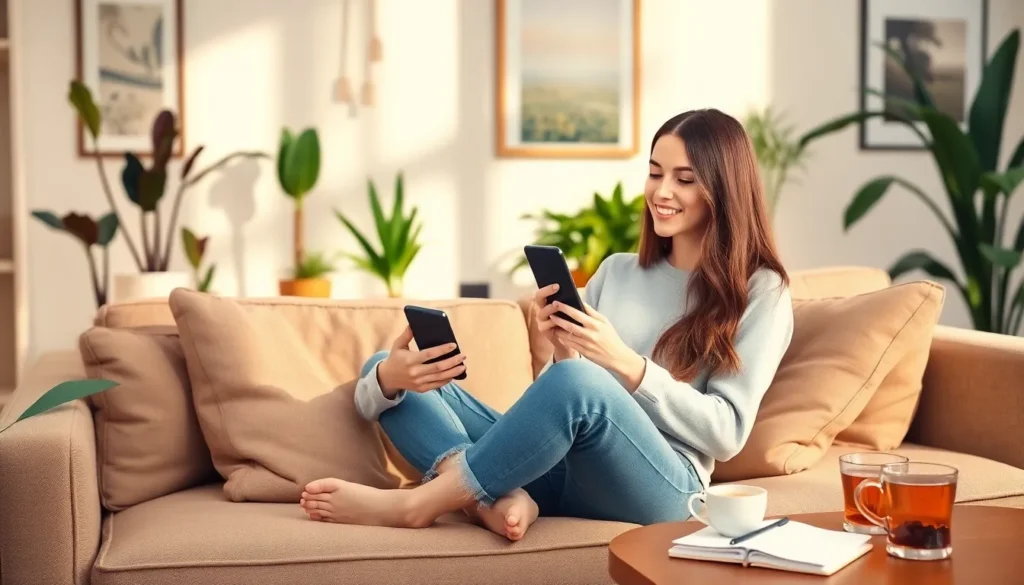In today’s fast-paced world, technology is both a blessing and a curse for mental health. With a smartphone in nearly every pocket and apps designed to help with everything from meditation to mood tracking, it’s hard to ignore the digital revolution’s impact on our minds. But let’s face it: while scrolling through cat memes may provide a momentary giggle, it can’t replace the power of face-to-face conversations.
Technology and Mental Health
Technology’s impact on mental health is multifaceted. On one hand, it offers tools such as smartphones and mental health apps, which facilitate practices like meditation, mood tracking, and therapy access. These resources can enhance wellness, providing support that many people find beneficial.
Digital platforms serve as communication channels, allowing users to connect with mental health professionals remotely. This accessibility represents a significant advantage, removing barriers such as travel and scheduling conflicts. Many users engage with content that promotes mental well-being, including articles, podcasts, and online support groups.
On the other hand, excessive screen time poses risks. Social media can lead to feelings of inadequacy and anxiety, driven by unrealistic comparisons. Users often report experiencing heightened loneliness despite being connected online. The immediate gratification from viewing memes may provide temporary joy but lacks the depth found in face-to-face interactions.
Balancing technology usage is crucial for mental health. Awareness of the effects of constant connectivity leads individuals to make more informed choices. Reducing screen time and prioritizing in-person socializing can improve overall well-being. Ultimately, understanding both the benefits and drawbacks of technology empowers individuals to leverage its advantages while mitigating potential harms.
Benefits of Technology in Mental Health


Technology enhances mental health support by providing accessible tools and resources. Utilization of digital platforms can foster connections with mental health professionals and peers.
Teletherapy and Online Counseling
Teletherapy offers individuals convenient access to professional support. Most platforms allow clients to communicate via video calls, chats, or phone sessions. Flexibility in scheduling helps bypass traditional barriers, such as travel or busy routines. Accessibility often encourages people who might hesitate to seek help otherwise. Research shows that teletherapy provides similar effectiveness compared to in-person therapy, ensuring quality treatment remains intact. Security measures ensure personal information is protected, making online counseling a safe option for many.
Mental Health Apps and Tools
Numerous mental health apps assist users in managing their wellness. Meditation applications provide guided sessions that promote mindfulness and relaxation techniques. Mood tracking tools enable individuals to log emotional patterns, which can identify triggers over time. Educational content on these platforms offers articles and videos that enhance mental health literacy. Online support communities within these apps facilitate connection among users facing similar challenges. Statistics indicate that consistent engagement with these tools can lead to significant improvements in well-being and self-awareness.
Challenges of Technology in Mental Health
Technology presents several challenges in the realm of mental health. Awareness of these issues enables individuals to navigate the digital landscape more effectively.
Privacy Concerns
Privacy concerns rank highly among the challenges linked to mental health technology. Users often share sensitive information through apps and platforms. Data breaches can expose personal details, leading to anxiety about confidentiality. Regulations such as the Health Insurance Portability and Accountability Act (HIPAA) emphasize the need for secure data handling. Users should prioritize platforms with robust security protocols. Transparency from providers about data usage can promote trust. Understanding these risks supports informed choices regarding technology in mental health.
Digital Addiction
Digital addiction also impacts mental health significantly. Many individuals find themselves spending hours online, affecting their daily lives and well-being. Excessive screen time can lead to reduced face-to-face interactions, contributing to feelings of isolation. Research indicates that over 60% of adults experience compulsion surrounding device usage. These habits can disrupt sleep patterns and increase anxiety levels. Engaging in mindful technology use fosters healthier boundaries. Ultimately, recognizing digital addiction as a significant concern leads to proactive measures for mental wellness.
The Role of Social Media
Social media plays a significant role in shaping mental health today. It offers both advantages and disadvantages that users must navigate carefully.
Positive Effects of Social Media
Social media connects users with supportive communities. Individuals can share experiences and find validation from others facing similar challenges. Online platforms also provide access to mental health resources, including articles and expert advice. Users often find inspiration through uplifting content that promotes well-being. Engagement in online support groups fosters a sense of belonging, combating feelings of isolation. Some studies indicate that users who participate in these communities experience improved mental health outcomes. Posting achievements or progress can boost self-esteem and encourage others.
Negative Effects of Social Media
Social media creates challenges for mental health. Feelings of inadequacy often arise from unrealistic comparisons. Users may experience heightened anxiety when viewing curated lifestyles that seem unattainable. Loneliness can paradoxically increase despite being constantly connected. Cyberbullying, a prevalent issue, further contributes to negative self-image and emotional distress. Research shows a correlation between excessive social media use and depression, particularly among adolescents. Privacy concerns arise as users share personal information, increasing anxiety over data security. Continuous notifications can contribute to digital overload, resulting in diminished focus and increased stress.
Future Trends in Technology and Mental Health
Emerging technologies continue to shape the landscape of mental health care. Virtual reality (VR) is gaining traction as a therapeutic tool, enabling immersive environments for exposure therapy. Studies show that VR can effectively treat conditions like PTSD and anxiety disorders by simulating real-world experiences in a safe space.
Artificial intelligence (AI) also plays a crucial role in the evolving mental health sector. AI-driven chatbots offer immediate support, guiding users through anxiety management exercises and providing resources. These tools can deliver personalized recommendations based on user input, minimizing the need for traditional therapy for some.
Wearable technology is gaining popularity among individuals seeking real-time mental health monitoring. Devices like smartwatches track physiological indicators such as heart rate variability and sleep patterns, offering insights into stress levels. Users can identify triggers and adjust their behaviors accordingly, promoting proactive management of mental wellness.
Teletherapy is becoming more widely accepted as a standard method for mental health care. The convenience of accessing professionals via video calls creates a more flexible treatment model. Increased acceptance among users leads to more individuals seeking help who may have previously hesitated due to stigma or logistical challenges.
Social media platforms are evolving to enhance user experience by fostering mental health awareness. Many platforms now highlight mental health resources and connections to support networks directly in their feeds. Positive engagement with these resources can enhance user wellbeing and reduce feelings of isolation.
These trends illustrate a growing integration of technology in mental health, emphasizing the importance of secure, accessible, and personalized care for users. Adapting to these advancements can significantly improve mental health outcomes for diverse populations.
Conclusion
Technology’s influence on mental health is profound and multifaceted. While it offers innovative solutions for support and connection, it also presents challenges that require careful navigation. Understanding the balance between utilizing technology for well-being and recognizing its potential drawbacks is essential.
As individuals embrace the benefits of mental health apps and teletherapy, they must remain vigilant about privacy and digital addiction. By fostering a mindful approach to technology use, people can enhance their mental wellness while avoiding the pitfalls of excessive screen time and social media pressures.
The future of mental health care will likely continue to evolve with emerging technologies, making it crucial for users to stay informed and proactive in their mental health journeys.
